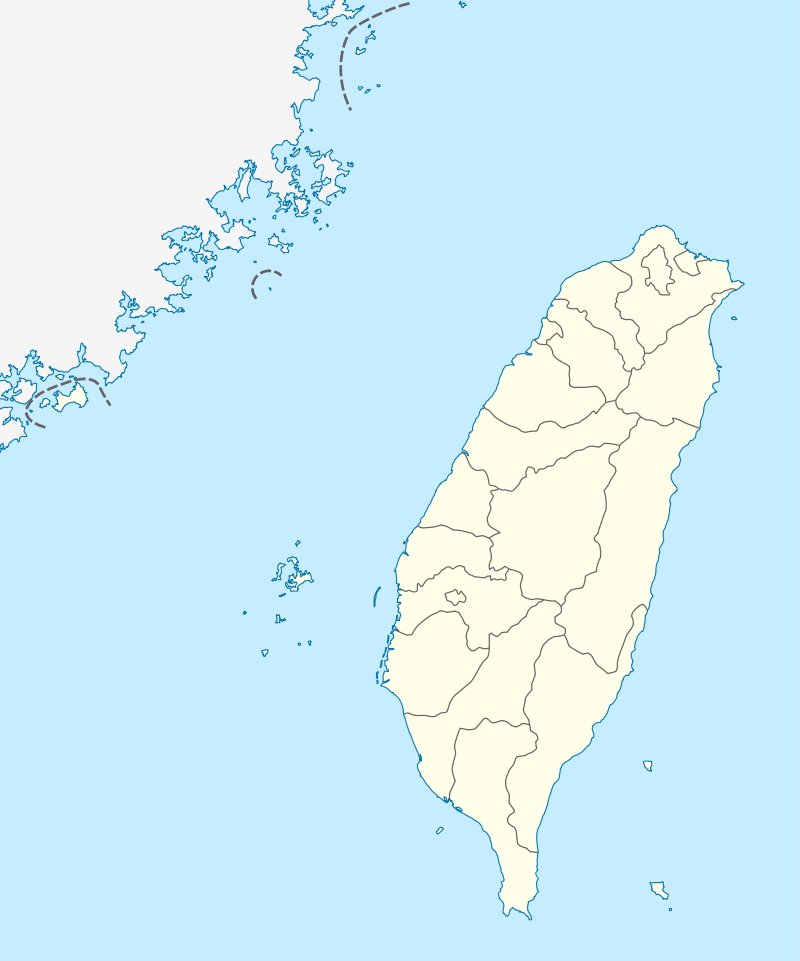Hsinchu railway station
Hsinchu (Chinese: 新竹; pinyin: Xīnzhú) is a railway station in East District, Hsinchu City, Taiwan served by Taiwan Railways Administration. Hsinchu Station is a major station on the West Coast line and the western terminus of the Neiwan line.
| TRA railway station | |||||||||||||||||
 Exterior | |||||||||||||||||
| Chinese name | |||||||||||||||||
| Traditional Chinese | 新竹 | ||||||||||||||||
| |||||||||||||||||
| General information | |||||||||||||||||
| Location | 445 Sec 2 Zhonghua Rd East District, Hsinchu City[1] Taiwan | ||||||||||||||||
| Coordinates | 24.8016°N 120.9716°E[1] | ||||||||||||||||
| Line(s) | |||||||||||||||||
| Distance | 106.4 km to Keelung[2] | ||||||||||||||||
| Connections | |||||||||||||||||
| Construction | |||||||||||||||||
| Structure type | Ground level | ||||||||||||||||
| Other information | |||||||||||||||||
| Station code | |||||||||||||||||
| Classification | First class (Chinese: 一等)[4] | ||||||||||||||||
| Website | www | ||||||||||||||||
| History | |||||||||||||||||
| Opened | 1893-11-30[5][6] | ||||||||||||||||
| Rebuilt | 1913 | ||||||||||||||||
| Electrified | 1978-01-09[7] | ||||||||||||||||
| Previous names | Shinchiku (Japanese: 新竹) | ||||||||||||||||
| Traffic | |||||||||||||||||
| Passengers (2017) | 15.020 million per year[3] | ||||||||||||||||
| Rank | 7 out of 228 | ||||||||||||||||
| Services | |||||||||||||||||
| |||||||||||||||||
| Location | |||||||||||||||||
 Hsinchu Location within Taiwan | |||||||||||||||||
Structure
There are two island platforms and one side platform, as well as the historic fourth-generation European-style station building which opened in 1913, during Japanese rule.
Roundhouse
Garages used in railway locomotives are generally large circular or semi-circular structures and surround the transfer disk or beside the transfer disk.
Steam train classic photo
Launch at the same time. DT595.CT192.DT673, only in Hsinchu railway station .
- This scene is only to be remembered.
Service
Except Tzu-Chiang Limited Express southbound 133, 143, northbound 138, and some Taroko Expresses, all other trains stop at Hsinchu Station. It is also the main destination of commuter local trains in Northern Taiwan. Neiwan line trains travel from this station to Neiwan Station. Connection to the THSR Hsinchu Station is available through Liujia line (which branches off from the Neiwan line's Zhuzhong Station).
Around the station
Sister stations
Hsinchu Station has "sister station" agreements with Grand Central Terminal in USA since August 2013 and with Tokyo Station in Japan since February 2015.[8]
See also
- List of railway stations in Taiwan
References
- "車站基本資料集". Taiwan Railways Administration. Archived from the original on 27 October 2018. Retrieved 3 November 2018.
- "Archived copy" 各站營業里程-1.西部幹線. Taiwan Railways Administration (in Chinese). 11 December 2008. Archived from the original on 29 August 2018. Retrieved 1 September 2018.CS1 maint: archived copy as title (link)
- "Archived copy" 臺鐵統計資訊. Taiwan Railways Administration (in Chinese). Archived from the original on 30 August 2018. Retrieved 1 September 2018.CS1 maint: archived copy as title (link)
- "Archived copy" 車站數-按等級別分 (PDF). Taiwan Railways Administration (in Chinese). Archived from the original (PDF) on 30 October 2018. Retrieved 30 October 2018.CS1 maint: archived copy as title (link)
- Lee, Yung-chang (April 2017). A Living Landmark (PDF). Taipei, Taiwan: Taiwan Railways Administration, MOTC. ISBN 978-986-05-1933-4. Archived from the original (PDF) on 31 August 2018. Retrieved 4 September 2018.
- "Archived copy" 車站歷史. Taiwan Railways Administration (in Chinese). 11 December 2008. Archived from the original on 5 September 2018. Retrieved 5 September 2018.CS1 maint: archived copy as title (link)
- "Archived copy" 臺灣鐵路電訊. Taiwan Railways Administration (in Chinese). Archived from the original on 4 September 2018. Retrieved 4 September 2018.CS1 maint: archived copy as title (link)
- "Tokyo Station to get a sister station in Taiwan". The Japan Times. Japan: The Japan Times Ltd. 10 February 2015. Retrieved 12 February 2015.
External links
| Wikimedia Commons has media related to TRA Hsinchu Station. |
- TRA Hsinchu Station (in Chinese)
- TRA Hsinchu Station